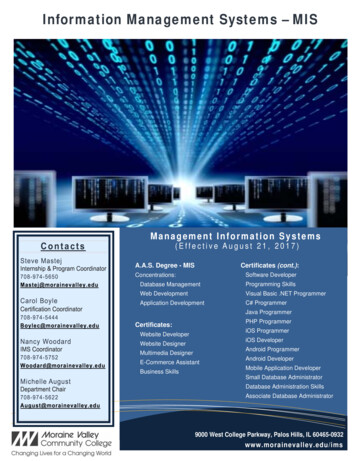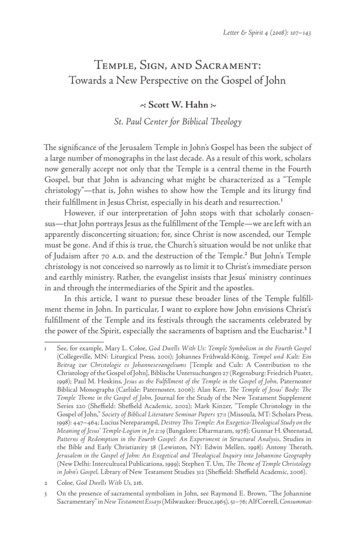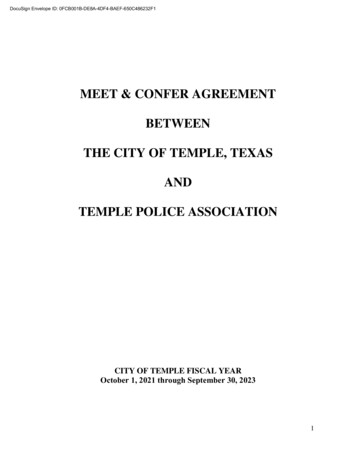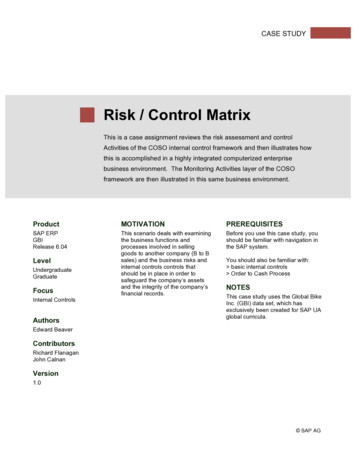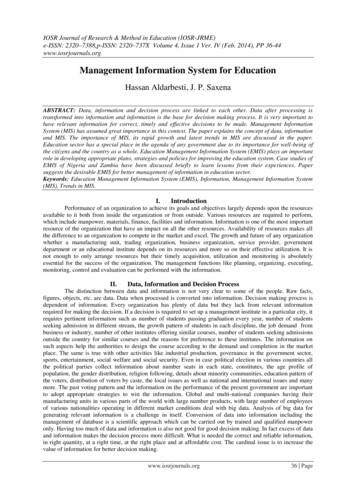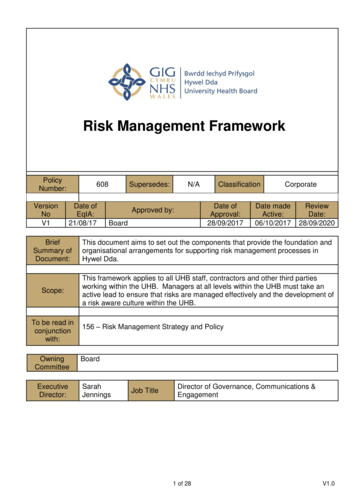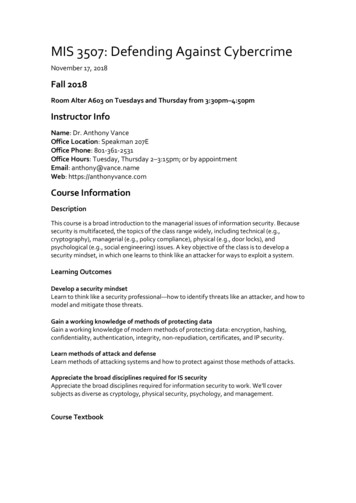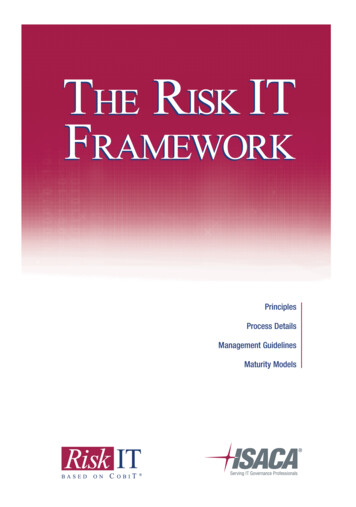
Transcription
THE RISK ITFRAMEWORKPrinciplesProcess DetailsManagement GuidelinesMaturity Models
THE RISK IT FRAMEWORKISACA With more than 86,000 constituents in more than 160 countries, ISACA (www.isaca.org) is a leading global provider of knowledge,certifications, community, advocacy and education on information systems assurance and security, enterprise governance of IT, andIT-related risk and compliance. Founded in 1969, ISACA sponsors international conferences, publishes the ISACA Journal, anddevelops international information systems auditing and control standards. It also administers the globally respected CertifiedInformation Systems Auditor (CISA ), Certified Information Security Manager (CISM ) and Certified in the Governanceof Enterprise IT (CGEIT ) designations.ISACA developed and continually updates the COBIT , Val IT and Risk IT frameworks, which help IT professionals and enterprise leadersfulfil their IT governance responsibilities and deliver value to the business.DisclaimerISACA has designed and created The Risk IT Framework (the ‘Work’) primarily as an educational resource for chief information officers(CIOs), senior management and IT management. ISACA makes no claim that use of any of the Work will assure a successful outcome.The Work should not be considered inclusive of all proper information, procedures and tests or exclusive of other information, proceduresand tests that are reasonably directed to obtaining the same results. In determining the propriety of any specific information, procedure ortest, officers and managers should apply their own professional judgement to the specific control circumstances presented by the particularsystems or information technology environment.Reservation of Rights 2009 ISACA. All rights reserved. No part of this publication may be used, copied, reproduced, modified, distributed, displayed, stored ina retrieval system or transmitted in any form by any means (electronic, mechanical, photocopying, recording or otherwise) without the priorwritten authorisation of ISACA. Reproduction and use of all or portions of this publication are permitted solely for academic, internal andnon-commercial use and for consulting/advisory engagements, and must include full attribution of the material’s source. No other right orpermission is granted with respect to this work.ISACA3701 Algonquin Road, Suite 1010Rolling Meadows, IL 60008 USAPhone: 1.847.253.1545Fax: 1.847.253.1443E-mail: info@isaca.orgWeb site: www.isaca.orgISBN 978-1-60420-111-6The Risk IT FrameworkPrinted in the United States of AmericaCGEIT is a trademark/service mark of ISACA. The mark has been applied for or registered in countries throughout the world.2 2009 ISACA. AL LRI G H T SRE S E R V E D.
AcknowledgementsAcknowledgementsISACA wishes to recognise:Development TeamSteven De Haes, Ph.D., University of Antwerp Management School, BelgiumGert du Preez, CGEIT, PricewaterhouseCoopers, BelgiumRachel Massa, CISSP, PricewaterhouseCoopers LLP, USABart Peeters, PricewaterhouseCoopers, BelgiumSteve Reznik, CISA, PricewaterhouseCoopers LLP, USADirk Steuperaert, CISA, CGEIT, IT In Balance BVBA, BelgiumIT Risk Task Force (2008-2009)Urs Fischer, CISA, CIA, CPA (Swiss), Swiss Life, Switzerland, ChairSteven Babb, CGEIT, KPMG, UKBrian Barnier, CGEIT, ValueBridge Advisors, USAJack Jones, CISA, CISM, CISSP, Risk Management Insight LLC, USAJohn W. Lainhart IV, CISA, CISM, CGEIT, IBM Business Consulting Services, USAGladys Rouissi, CISA, MComp, Commonwealth Bank of Australia, AustraliaLisa R. Young, CISA, CISSP, Carnegie Mellon University, USAExpert ReviewersMark Adler, CISA, CISM, CGEIT, CFE, CFSA, CIA, CISSP, Commercial Metals, USASteven Babb, CGEIT, KPMG, UKGary Baker, CGEIT, CA, Deloitte and Touche LLP, CanadaDave H. Barnett, CISM, CISSP, CSDP, CSSLP, Applied Biosystems, USABrian Barnier, CGEIT, ValueBridge Advisors, USALaurence J. Best, PricewaterhouseCoopers LLP, USAPeter R. Bitterli, CISA, CISM, Bitterli Consulting AG, SwitzerlandLuis Blanco, CISA, Citibank, UKAdrian Bowles, Ph.D., Sustainability Insights Group (SIG411), USADirk Bruyndonckx, CISA, CISM, CGEIT, MCA, KPMG Advisory, BelgiumOlivia Xardel-Burtin, Grand Duchy of LuxembourgM. Christophe Burtin, Grand Duchy of LuxembourgRahul Chaurasia, Student, Indian Institute of Information Technology, IndiaPhilip De Picker, CISA, MCA, Nationale Bank van Belgie, BelgiumRoger Debreceny, Ph.D., FCPA, University of Hawaii-Manoa, USAHeidi L. Erchinger, CISA, CISSP, System Security Solutions Inc., USARobert Fabian, Ph.D., I.S.P., Independent Consultant, CanadaUrs Fischer, CISA, CIA, CPA (Swiss), Swiss Life, SwitzerlandShawna Flanders, CISA, CISM, ACS, PSCU Financial Services, USAJohn Garms, CISM, CISSP, ISSEP, Electric-Tronics Inc., USADennis Gaughan, AMR Research, USAYalcin Gerek, CISA, CGEIT, TAC, TurkeyEdson Gin, CISA, CFE, CIPP, SSCP, USAPete Goodhart, PricewaterhouseCoopers LLP, USAGary Hardy, CGEIT, IT Winners, South AfricaWinston Hayden, ITGS Consultants, South AfricaJimmy Heschl, CISA, CISM, CGEIT, KPMG, AustriaMonica Jain, CGEIT, CSQA, CSSBB, USAJack Jones, CISA, CISM, CISSP, Risk Management Insight LLC, USADharmesh Joshi, CISA, CGEIT, CA, CIA, CISSP, CIBC, CanadaCatherine I. Jourdan, PricewaterhouseCoopers LLP, USAKamal Khan, CISA, CISSP, MBCS, Saudi Aramco, Saudi ArabiaMarty King, CISA, CGEIT, CPA, BCBSNC, USATerry Kowalyk, Credit Union Deposit Guarantee Corp., CanadaDenis Labhart, Swiss Life, SwitzerlandJohn W. Lainhart IV, CISA, CISM, CGEIT, IBM Business Consulting Services, USAPhilip Le Grand, Datum International Ltd., UKBjarne Lonberg, CISSP, A.P. Moller—Maersk, DenmarkJo Lusk, CISA, Federal Government, USACharles Mansour, CISA, Charles Mansour Audit and Risk Service, UKMario Micallef, CGEIT, CPAA, FIA, Ganado & Associates, MaltaJack Musgrove, CGEIT, CMC, BI International, USAPaul Phillips, Barclays Bank Plc, UKAndre Pitkowski, CGEIT, OCTAVE, APIT Informatica, BrazilJack M. Pullara, CISA, PricewaterhouseCoopers LLP, USA 2009 ISACA. AllRi g h t sRe s e r v e d.3
THE RISK IT FRAMEWORKACKNOWLEDGEMENTS (cont.)Expert Reviewers (cont.)Felix Ramirez, CISA, CGEIT, Riebeeck Associates, USAGladys Rouissi, CISA, MComp, Commonwealth Bank of Australia, AustraliaDaniel L. Ruggles, CISM, CGEIT, CISSP, CMC, PMP, PM Kinetics LLC, USAStephen J. Russell, PricewaterhouseCoopers LLP, USADeena Lavina Saldanha, CISA, CISM, Obegi Chemicals LLC, UAEMark Scherling, CanadaGustavo Adolfo Solis Montes, Grupo Cynthus SA de CV, MexicoJohn Spangenberg, SeaQuation, The NetherlandsRobert E. Stroud, CGEIT, CA Inc., USAJohn Thorp, CMC, I.S.P., The Thorp Network, CanadaLance M. Turcato, CISA, CISM, CGEIT, CPA, CITP, City of Phoenix, USAKenneth Tyminski, Retired, USAE.P. van Heijningen, Ph.D., RA, ING Group, The NetherlandsSylvain Viau, CISA, CGEIT, ISO Lead Auditor, 712iem Escadron de Communication, CanadaGreet Volders, CGEIT, Voquals NV, BelgiumThomas M. Wagner, Marsh Risk Consulting, CanadaOwen Watkins, ACA, MBCS, Siemens, UKClive E. Waugh, CISSP, CEH, Intuit, USAAmanda Xu, CISA, CISM, Indymac Bank, USALisa R. Young, CISA, CISSP, Carnegie Mellon University, USAISACA Board of DirectorsEmil D’Angelo, CISA, CISM, Bank of Tokyo Mitsubishi UFJ, USA, International PresidentGeorge Ataya, CISA, CISM, CGEIT, CISSP, ICT Control SA-NV, Belgium, Vice PresidentYonosuke Harada, CISA, CISM, CGEIT, CAIS, InfoCom Research Inc., Japan, Vice PresidentRia Lucas, CISA, CGEIT, Telstra Corp. Ltd., Australia, Vice PresidentJose Angel Pena Ibarra, CGEIT, Alintec, Mexico, Vice PresidentRobert E. Stroud, CGEIT, CA Inc., USA, Vice PresidentKenneth L. Vander Wal, CISA, CPA, Ernst & Young LLP (retired), USA, Vice PresidentRolf von Roessing, CISA, CISM, CGEIT, KPMG Germany, Germany, Vice PresidentLynn Lawton, CISA, FBCS CITP, FCA, FIIA, KPMG LLP, UK, Past International PresidentEverett C. Johnson Jr., CPA, Deloitte & Touche LLP (retired), USA, Past International PresidentGregory T. Grocholski, CISA, The Dow Chemical Company, USA, DirectorTony Hayes, CGEIT, AFCHSE, CHE, FACS, FCPA, FIIA, Queensland Government, Australia, DirectorHoward Nicholson, CISA, CGEIT, City of Salisbury, Australia, DirectorJeff Spivey, CPP, PSP, Security Risk Management, USA, TrusteeFramework CommitteePatrick Stachtchenko, CISA, CGEIT, CA, Stachtchenko & Associes SAS, France, ChairGeorge Ataya, CISA, CISM, CGEIT, CISSP, ICT Control SA-NV, Belgium, Vice PresidentSteven A. Babb, CGEIT, United KingdomSergio Fleginsky, CISA, Akzonobel, UruguayJohn W. Lainhart, IV, CISA, CISM, CGEIT, IBM Global Business Services, USAMario C. Micallef, CGEIT, CPAA, FIA, MaltaDerek J. Oliver, CISA, CISM, CFE, FBCS, United KingdomRobert G. Parker, CISA, CA, CMC, FCA, CanadaJo Stewart-Rattray, CISA, CISM, CGEIT, RSM Bird Cameron, AustraliaRobert E. Stroud, CGEIT, CA Inc., USARolf M. von Roessing, CISA, CISM, CGEIT, KPMG Germany, GermanySpecial RecognitionTo the following members of the 2008-2009 IT Governance Committee who initiated the project and steered it to a successful conclusion:Tony Hayes, CGEIT, AFCHSE, CHE, FACS, FCPA, FIIA, Queensland Government, Australia, ChairSushil Chatterji, Edutech Enterprises, SingaporeKyung-Tae Hwang, CISA, Dongguk University, KoreaJohn W. Lainhart IV, CISA, CISM, CGEIT, IBM Business Consulting Services, USAHugh Penri-Williams, CISA, CISM, CCSA, CIA, Glaniad 1865 Eurl, FranceGustavo Adolfo Solis Montes, CISA, CISM, Grupo Cynthus SA de CV, MexicoRobert E. Stroud, CGEIT, CA Inc., USAJohn Thorp, CMC, I.S.P., The Thorp Network Inc., CanadaWim Van Grembergen, Ph.D., University of Antwerp Management School and IT Alignment and Governance Research Institute, Belgium4 2009 ISACA. AL LRI G H T SRE S E R V E D.
TABLE OF CONTENTSTABLE OF CONTENTS1. Executive Summary . 72. Risk IT Framework—Purpose and Target Audience . 11IT Risk . 11Purpose of the Risk IT Framework . 11Intended Audiences and Stakeholders . 12Benefits and Outcomes . 123. Risk IT Principles . 134. The Risk IT Framework . 155. Essentials of Risk Governance . 17Risk Appetite and Tolerance . 17Responsibilities and Accountability for IT Risk Management . 18Awareness and Communication . 18Risk Culture . 226. Essentials of Risk Evaluation . 23Describing Business Impact. 23IT Risk Scenarios . 247. Essentials of Risk Response . 27Key Risk Indicators . 27Risk Response Selection and Prioritisation . 298. Risk and Opportunity Management Using COBIT, Val IT and Risk IT . 319. The Risk IT Framework Process Model Overview . 3310. Managing Risk in Practice—The Practitioner Guide Overview . 3511. Overview of the Risk IT Framework Process Model . 37Detailed Process Descriptions. 3712. The Risk IT Framework . 43RG1 Establish and maintain a common risk view. 45RG2 Integrate with ERM. . 51RG3 Make risk-aware business decisions. . 57RE1 Collect data. . 65RE2 Analyse risk. 69RE3 Maintain risk profile. . 73RR1 Articulate risk. . 81RR2 Manage risk. . 85RR3 React to events. . 90Appendix 1. Overview of Reference Materials . 97Appendix 2. High-level Comparison of Risk IT With OtherRisk Management Frameworks and Standards . 99Appendix 3. Risk IT Glossary . 101List of Figures . 103Other ISACA Publications . 104 2009 ISACA. AL LRI G H T SRE S E R V E D.5
THE RISK IT FRAMEWORKPage intentionally left blank6 2009 ISACA. AL LRI G H T SRE S E R V E D.
EXECUTIVE SUMMARY1. EXECUTIVE SUMMARYThis document forms part of ISACA’s Risk IT initiative, which is dedicated to helping enterprises manage IT-related risk. The collectiveexperience of a global team of practitioners and experts, and existing and emerging practices and methodologies for effective IT riskmanagement, have been consulted in the development of the Risk IT framework. Risk IT is a framework based on a set of guiding principlesand featuring business processes and management guidelines that conform to these principles.The Risk IT framework complements ISACA’s COBIT1, which provides a comprehensive framework for the control and governance ofbusiness-driven information-technology-based (IT-based) solutions and services. While COBIT sets good practices for the means of riskmanagement by providing a set of controls to mitigate IT risk, Risk IT sets good practices for the ends by providing a framework forenterprises to identify, govern and manage IT risk.The Risk IT framework is to be used to help implement IT governance, and enterprises that have adopted (or are planning to adopt) COBIT astheir IT governance framework can use Risk IT to enhance risk management.The COBIT processes manage all IT-related activities within theenterprise. These processes have to deal with events internal orexternal to the enterprise. Internal events can include operational ITincidents, project failures, full (IT) strategy switches and mergers.External events can include changes in market conditions, newcompetitors, new technology becoming available and new regulationsaffecting IT. These events all pose a risk and/or opportunity and needto be assessed and responses developed. The risk dimension, and howto manage it, is the main subject of the Risk IT framework. Whenopportunities for IT-enabled business change are identified, the ValIT framework best describes how to progress and maximise the returnon investment. The outcome of the assessment will probably havean impact on some of the IT processes and/or on the input to the ITprocesses; hence, the arrows from the ‘Risk Management’ and ‘ValueManagement’ boxes are directed back to the ‘IT Process Management’area in figure 1.Figure 1—Positioning COBIT, Val IT and Risk ITBusiness Objective—Trust and Value—FocusVal ITRisk ITRiskManagementIdentify Riskand OpportunityValueManagementIT-relatedEventsIT ProcessManagementIT risk is business risk—specifically, the business risk associated withthe use, ownership, operation, involvement, influence and adoptionof IT within an enterprise. It consists of IT-related events that couldpotentially impact the business. It can occur with both uncertainfrequency and magnitude, and it creates challenges in meetingstrategic goals and objectives. IT risk can be categorised in differentways (see figure 2).COBITIT-related Activity FocusFigure 2—IT Risk Categories)\ZPULZZ HS\LExamplesIT Benefit/ValueEnablementIT Programmeand Project DeliveryIT Operations andService Delivery-HPS [V .HPU.HPUs 4ECHNOLOGY ENABLER FORnew business initiativess 4ECHNOLOGY ENABLER FORefficient operationss 0ROJECT QUALITYs 0ROJECT RELEVANCEs 0ROJECT OVERRUNs )4 SERVICE INTERRUPTIONSs 3ECURITY PROBLEMSs #OMPLIANCE ISSUES3VZL7YLZLY]L)\ZPULZZ HS\L1ISACA, COBIT 4.1, 2008, www.isaca.org 2009 ISACA. AL LRI G H T SRE S E R V E D.7
THE RISK IT FRAMEWORKs )4 BENEFIT VALUE ENABLEMENT RISK !SSOCIATED WITH MISSED OPPORTUNITIES TO USE TECHNOLOGY TO IMPROVE EFFICIENCY OR EFFECTIVENESS OFbusiness processes, or as an enabler for new business initiativess )4 PROGRAMME AND PROJECT DELIVERY RISK !SSOCIATED WITH THE CONTRIBUTION OF )4 TO NEW OR IMPROVED BUSINESS SOLUTIONS USUALLY IN THE FORMof projects and programmes. This ties to investment portfolio management (as described in the Val IT framework).s )4 OPERATIONS AND SERVICE DELIVERY RISK !SSOCIATED WITH ALL ASPECTS OF THE PERFORMANCE OF )4 SYSTEMS AND SERVICES WHICH CAN BRINGdestruction or reduction of value to the enterpriseIT risk always exists, whether or not it is detected or recognised by an enterprise.Figure 2 shows that for all categories of IT risk there is an equivalent upside. For example:s 3ERVICE DELIVERY )F SERVICE DELIVERY PRACTICES ARE STRENGTHENED THE ENTERPRISE CAN BENEFIT E G BY BEING READY TO ABSORB ADDITIONALtransaction volumes or market share.s 0ROJECT DELIVERY 3UCCESSFUL PROJECT DELIVERY BRINGS NEW BUSINESS FUNCTIONALITY It is important to keep this risk/benefit duality in mind during all risk-related decisions. For example, decisions should consider the exposurethat may result if a risk is not treated vs. the benefit if it is addressed, or the potential benefit that may accrue if opportunities are taken vs.missed benefits if opportunities are foregone.The Risk IT framework is aimed at a wide audience, as risk management is an all-encompassing and strategic requirement in any enterprise.The target audience includes:s 4OP EXECUTIVES AND BOARD MEMBERS WHO NEED TO SET DIRECTION AND MONITOR RISK AT THE ENTERPRISE LEVELs -ANAGERS OF )4 AND BUSINESS DEPARTMENTS WHO NEED TO DEFINE RISK MANAGEMENT PROCESSESs 2ISK MANAGEMENT PROFESSIONALS WHO NEED SPECIFIC )4 RISK GUIDANCEs %XTERNAL STAKEHOLDERSAdditional guidance is available in The Risk IT Practitioner Guide (summarised in this publication, with a more complete volume issuedseparately), including more practical examples and suggested methodologies, as well as detailed linking amongst Risk IT, COBIT and Val IT.The Risk IT framework is based on the principles of enterprise risk management (ERM) standards/frameworks such as COSO ERM2 andAS/NZS 43603 (soon to be complemented or replaced by ISO 31000) and provides insight on how to apply this guidance to IT. Risk ITapplies the proven and generally accepted concepts from these major standards/frameworks, as well as the main concepts from other IT riskmanagement related standards. However, the terminology used in Risk IT may sometimes differ from the one used in other standards, so forthose professionals who are more familiar with other risk management standards or frameworks we have provided extensive comparisonsbetween Risk IT and a number of existing major risk management standards in The Risk IT Practitioner Guide. Risk IT differs from existingIT risk guidance documents that focus solely on IT security in that Risk IT covers all aspects of IT risk.Although Risk IT aligns with major ERM frameworks, the presence and implementation of these frameworks is not a prerequisite foradopting Risk IT. By adopting Risk IT enterprises will automatically apply all ERM principles. In cases where ERM is present in someform, it is important to build on the strengths of the existing ERM programme—this will increase business buy-in and adoption of IT riskmanagement, save time and money, and avoid misunderstandings about specific IT risks that may be part of a bigger business risk.Risk IT defines, and is founded on, a number of guiding principles for effective management of IT risk. The principles are based oncommonly accepted ERM principles, which have been applied to the domain of IT. The Risk IT process model is designed and structured toenable enterprises to apply the principles in practice and to benchmark their performance.The Risk IT framework is about IT risk—in other words, business risk related to the use of IT. The connection to business is founded in theprinciples on which the framework is built, i.e., effective enterprise governance and management of IT risk, as shown in figure 5:s !LWAYS CONNECT TO BUSINESS OBJECTIVESs !LIGN THE MANAGEMENT OF )4 RELATED BUSINESS RISK WITH OVERALL %2s "ALANCE THE COSTS AND BENEFITS OF MANAGING )4 RISKs 0ROMOTE FAIR AND OPEN COMMUNICATION OF )4 RISKs %STABLISH THE RIGHT TONE FROM THE TOP WHILE DEFINING AND ENFORCING PERSONAL ACCOUNTABILITY FOR OPERATING WITHIN ACCEPTABLE ANDwell-defined tolerance levelss !RE A CONTINUOUS PROCESS AND PART OF DAILY ACTIVITIES2Committee of Sponsoring Organizations (COSO) of the Treadway Commission, Enterprise Risk Management—Integrated Framework, USA, 2004, www.coso.orgStandards Australia, AS/NZS 4360:2004, Australian/New Zealand Standard for Risk Management, Australia, 2004, www.saiglobal.com4ISACA, Enterprise Value: Governance of IT Investments, The Val IT Framework 2.0, USA, 2008, www.isaca.org38 2009 ISACA. AL LRI G H T SRE S E R V E D.
EXECUTIVE SUMMARYAround these building blocks a comprehensive process model is built for IT risk management that will look familiar to users of COBIT andVal IT4. Substantial guidance is provided on the key activities within each process, responsibilities for the process, and information flowsbetween processes and performance management of the process. The process model is divided into three domains—Risk Governance, RiskEvaluation and Risk Response—each containing three processes:s 2ISK 'OVERNANCE 2'– RG1 Establish and maintain a common risk view– RG2 Integrate with ERM– RG3 Make risk-aware business decisionss 2ISK %VALUATION 2%– RE1 Collect data– RE2 Analyse risk– RE3 Maintain risk profiles 2ISK 2ESPONSE 22– RR1 Articulate risk– RR2 Manage risk– RR3 React to eventsApplying good IT risk management practices as described in Risk IT will provide tangible business benefits, e.g., fewer operational surprisesand failures, increased information quality, greater stakeholder confidence, reduced regulatory concerns, and innovative applicationssupporting new business initiatives.The Risk IT framework is part of the ISACA product portfolio on IT governance. Although this document provides a complete and standalone framework, it does include references to COBIT. The practitioner guide issued in support of this framework makes extensive reference toCOBIT and Val IT, and it is recommended that managers and practitioners acquaint themselves with the major principles and contents of thosetwo frameworks.Like COBIT and Val IT, Risk IT is not a standard but a framework, including a process model and good practice guidance. This means thatenterprises can and should customise the components provided in the framework to suit their particular organisation and context. 2009 ISACA. AL LRI G H T SRE S E R V E D.9
THE RISK IT FRAMEWORKPage intentionally left blank10 2009 ISACA. AL LRI G H T SRE S E R V E D.
2. RISK IT FRAMEWORK—PURPOSE AND TARGET AUDIENCE2. RISK IT FRAMEWORK—PURPOSE AND TARGET AUDIENCEIT RiskIT risk is a component of the overall risk universe of the enterprise, as shown in figure 3. Other risks an enterprise faces include strategicrisk, environmental risk, market risk, credit risk, operational risk and compliance risk. In many enterprises, IT-related risk is considered tobe a component of operational risk, e.g., in the financial industry in the Basel II framework. However, even strategic risk can have an ITcomponent to it, especially where IT is the key enabler of new business initiatives. The same applies for credit risk, where poor IT (security)can lead to lower credit ratings. For that reason it is better not to depict IT risk with a hierarchic dependency on one of the other riskcategories, but perhaps as shown in the (financial industry-oriented) example given in figure 3.Figure 3—IT Risk in the Risk HierarchyIT risk is business risk—specifically, the business risk associated with the use, ownership, operation, involvement, influence and adoptionof IT within an enterprise. It consists of IT-related events and conditions that could potentially impact the business. It can occur with bothuncertain frequency and magnitude, and it creates challenges in meeting strategic goals and objectives. IT risk can be categorised in differentways:s )4 BENEFIT VALUE ENABLEMENT RISK !SSOCIATED WITH MISSED OPPORTUNITIES TO USE TECHNOLOGY TO IMPROVE EFFICIENCY OR EFFECTIVENESS OFbusiness processes, or as an enabler for new business initiativess )4 PROGRAMME AND PROJECT DELIVERY RISK !SSOCIATED WITH THE CONTRIBUTION OF )4 TO NEW OR IMPROVED BUSINESS SOLUTIONS USUALLY IN THE FORMof projects and programmes. This ties to investment portfolio management (as described in the Val IT framework).s )4 OPERATIONS AND SERVICE DELIVERY RISK !SSOCIATED WITH ALL ASPECTS OF THE PERFORMANCE OF )4 SYSTEMS AND SERVICES WHICH CAN BRINGdestruction or reduction of value to the enterpriseMany IT risk issues can occur because of third-party problems (service delivery as well as solution development)—both IT third partiesand business partners (e.g., supply chain IT risk caused at a major supplie
certifications, community, advocacy and education on information systems assurance and security, enterprise governance of IT, and IT-related risk and compliance. Founded in 1969, ISACA sponsors international conferences, publishes the ISACA Journal , and


